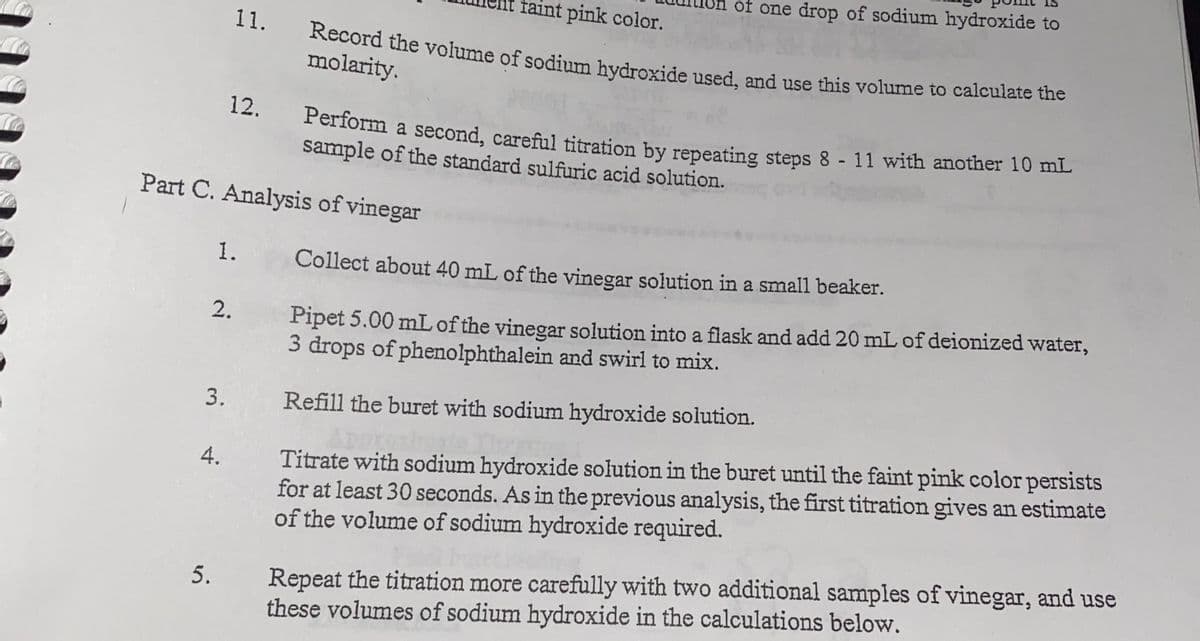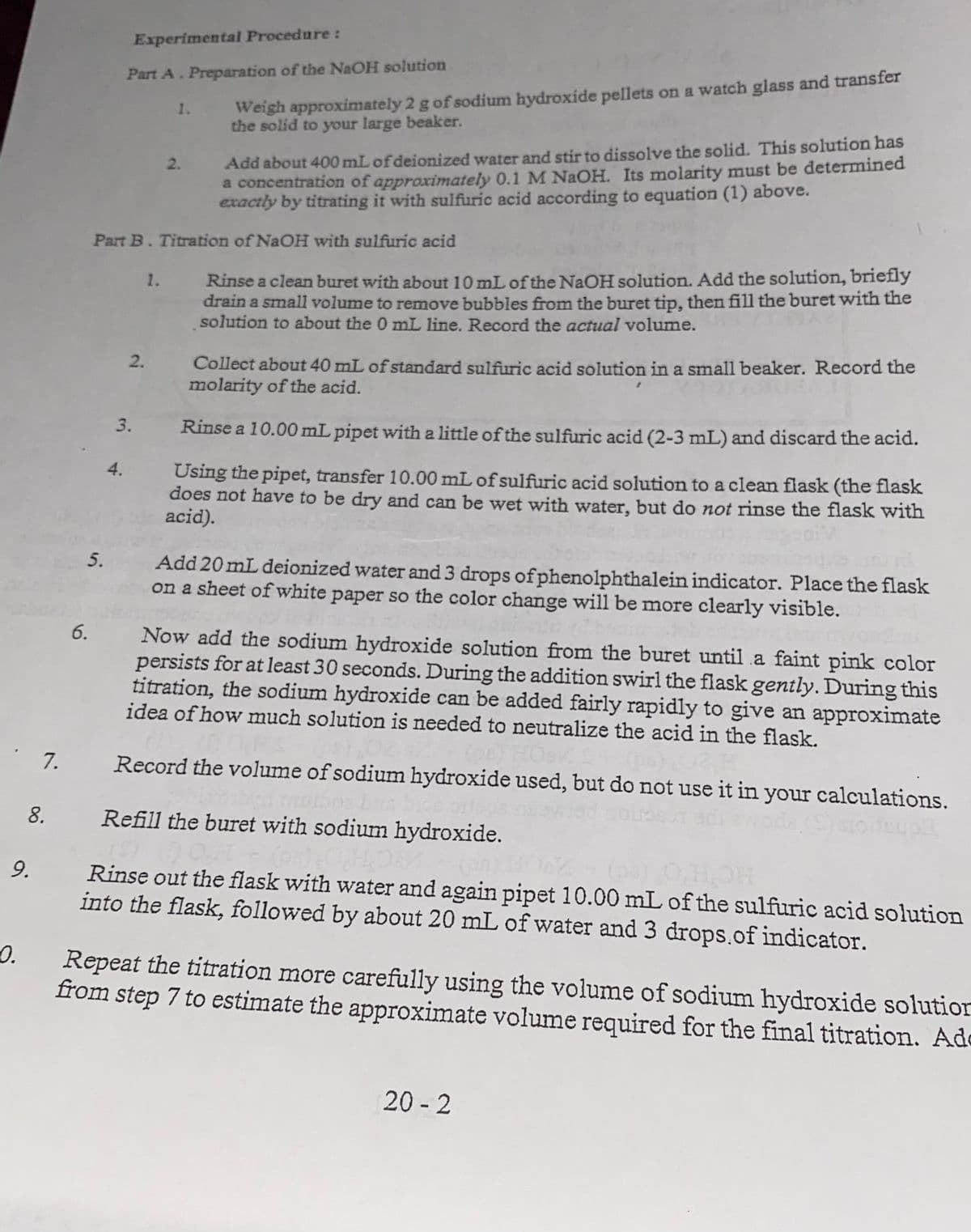Chapter80: Crystallization: Purification Of Solids
Section: Chapter Questions
Problem 4P
Related questions
Question
Calculate the molarity of the acetic acid in the vinegar solution.
given:
Given: Molarity of sulfuric acid:0.205 M
(Sodium hydroxide with sulfuric acid)Approx Titration-
initial buret reading : 0mL
finak buret reading : 31.8mL
titration 1-
initial buret reading : 0mL
finak buret reading : 31.5 mL
titration 2-
initial buret reading: 0mL
final buret reading : 31.7mL
Analysis of vinegar
Volume of vinegar solution:5mL
Approx titration -
initial buret reading : 0mL
final buret reading : 20.1 mL
titration 1-
initial buret reading : 0mL
final buret reading : 20.9mL
titration 2-
Volume of vinegar solution: 5mL
initial buret reading : 0mL
Final buret reading :20.0mL

Transcribed Image Text:of one drop of sodium hydroxide to
faint pink color.
Perform a second, careful titration by repeating steps 8 - 11 with another 10 mL
11.
Record the volume of sodium hydroxide used, and use this volume to calculate the
molarity.
12.
Perform a second, careful titration by repeating steps 8 - 11 with another 10 mL
sample of the standard sulfuric acid solution.
Part C. Analysis of vinegar
1.
Collect about 40 mL of the vinegar solution in a small beaker.
Pipet 5.00 mLof the vinegar solution into a flask and add 20 mL of deionized water,
3 drops of phenolphthalein and swirl to mix.
2.
3.
Refill the buret with sodium hydroxide solution.
Titrate with sodium hydroxide solution in the buret until the faint pink color persists
for at least 30 seconds. As in the previous analysis, the first titration gives an estimate
of the volume of sodium hydroxide required.
4.
Repeat the titration more carefully with two additional samples of vinegar, and use
these volumes of sodium hydroxide in the calculations below.
5.

Transcribed Image Text:Experimental Procedure:
Part A. Preparation of the NAOH solution
Weigh approximately 2 g of sodium hydroxide pellets on a watch glass and transfer
the solid to your large beaker.
1.
Add about 400 mL of deionized water and stir to dissolve the solid. This solution has
a concentration of approximately 0.1 M NAOH. Its molarity must be determined
exactly by titrating it with sulfuric acid according to equation (1) above.
2.
Part B. Titration of NaOH with sulfuric acid
1. Rinse a clean buret with about 10 mL of the NaOH solution. Add the solution, briefly
drain a small volume to remove bubbles from the buret tip, then fill the buret with the
solution to about the 0 mL line. Record the actual volume.
2.
Collect about 40 mL of standard sulfuric acid solution in a small beaker. Record the
molarity of the acid.
3.
Rinse a 10.00 mL pipet with a little of the sulfuric acid (2-3 mL) and discard the acid.
4.
Using the pipet, transfer 10.00 mL of sulfuric acid solution to a clean flask (the flask
does not have to be dry and can be wet with water, but do not rinse the flask with
acid).
5.
Add 20 mL deionized water and 3 drops ofphenolphthalein indicator. Place the flask
on a sheet of white paper so the color change will be more clearly visible.
6.
Now add the sodium hydroxide solution from the buret until a faint pink color
persists for at least 30 seconds. During the addition swirl the flask gently. During this
titration, the sodium hydroxide can be added fairly rapidly to give an approximate
idea of how much solution is needed to neutralize the acid in the flask.
7.
Record the volume of sodium hydroxide used, but do not use it in your calculations.
8.
Refill the buret with sodium hydroxide.
9.
Rinse out the flask with water and again pipet 10.00 mL of the sulfuric acid solution
into the flask, followed by about 20 mL of water and 3 drops.of indicator.
0.
Repeat the titration more carefully using the volume of sodium hydroxide solution
from step 7 to estimate the approximate volume required for the final titration. Ade
20 - 2
Expert Solution
This question has been solved!
Explore an expertly crafted, step-by-step solution for a thorough understanding of key concepts.
This is a popular solution!
Trending now
This is a popular solution!
Step by step
Solved in 3 steps

Knowledge Booster
Learn more about
Need a deep-dive on the concept behind this application? Look no further. Learn more about this topic, chemistry and related others by exploring similar questions and additional content below.Recommended textbooks for you

EBK A SMALL SCALE APPROACH TO ORGANIC L
Chemistry
ISBN:
9781305446021
Author:
Lampman
Publisher:
CENGAGE LEARNING - CONSIGNMENT

EBK A SMALL SCALE APPROACH TO ORGANIC L
Chemistry
ISBN:
9781305446021
Author:
Lampman
Publisher:
CENGAGE LEARNING - CONSIGNMENT